Paper Menu >>
Journal Menu >>
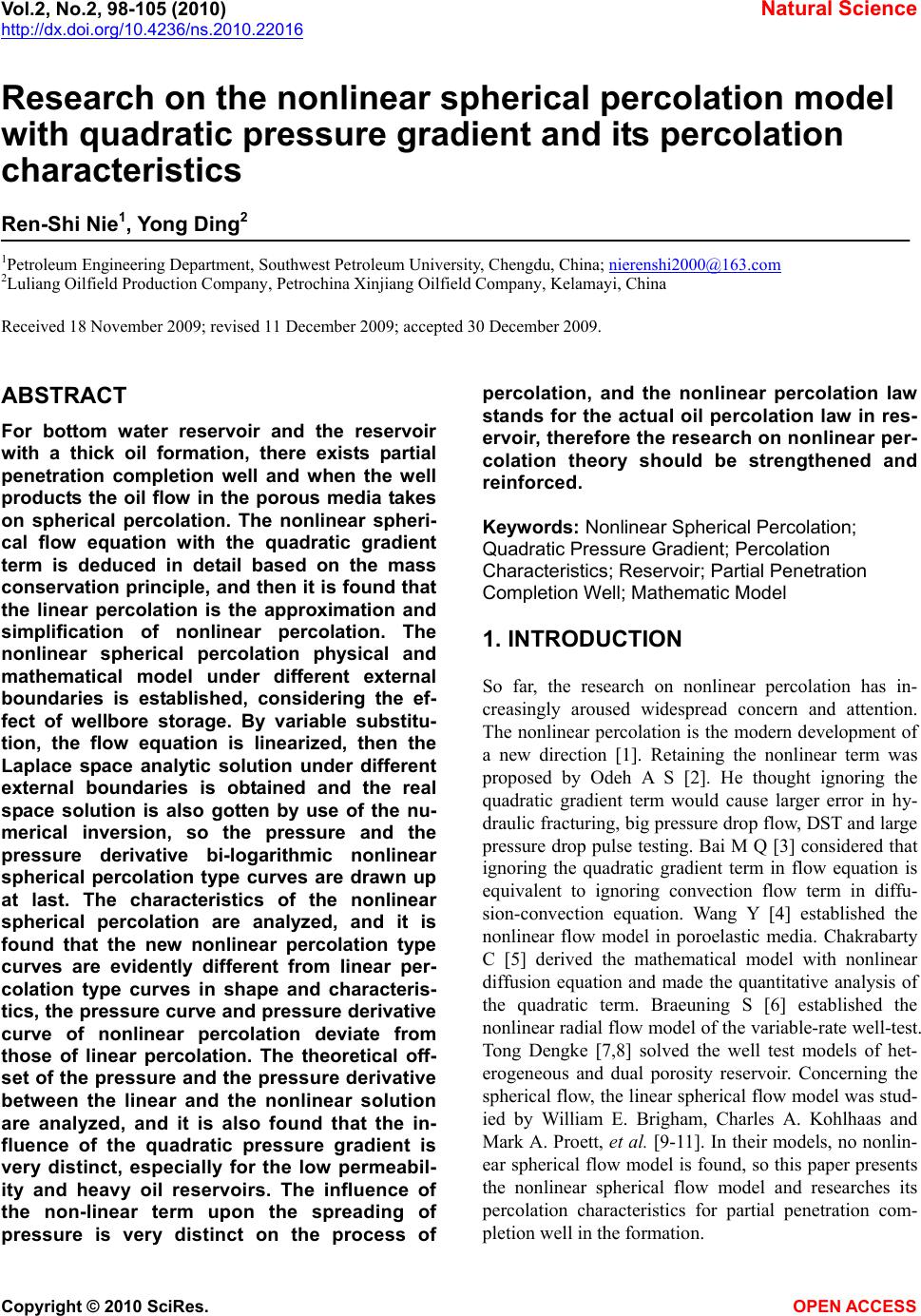 Vol.2, No.2, 98-105 (2010) Natural Science http://dx.doi.org/10.4236/ns.2010.22016 Copyright © 2010 SciRes. OPEN ACCESS Research on the nonlinear spherical percolation model with quadratic pressure gradient and its percolation characteristics Ren-Shi Nie1, Yong Ding2 1Petroleum Engineering Department, Southwest Petroleum University, Chengdu, China; nierenshi2000@163.com 2Luliang Oilfield Production Company, Petrochina Xinjiang Oilfield Company, Kelamayi, China Received 18 November 2009; revised 11 December 2009; accepted 30 December 2009. ABSTRACT For bottom water reservoir and the reservoir with a thick oil formation, there exists partial penetration completion well and when the well products the oil flow in the porous media takes on spherical percolation. The nonlinear spheri- cal flow equation with the quadratic gradient term is deduced in detail based on the mass conservation principle, and then it is found that the linear percolation is the approximation and simplification of nonlinear percolation. The nonlinear spherical percolation physical and mathematical model under different external boundaries is established, considering the ef- fect of wellbore storage. By variable substitu- tion, the flow equation is linearized, then the Laplace space analytic solution under different external boundaries is obtained and the real space solution is also gotten by use of the nu- merical inversion, so the pressure and the pressure derivative bi-logarithmic nonlinear spherical percolation type curves are drawn up at last. The characteristics of the nonlinear spherical percolation are analyzed, and it is found that the new nonlinear percolation type curves are evidently different from linear per- colation type curves in shape and characteris- tics, the pressure curve and pressure derivative curve of nonlinear percolation deviate from those of linear percolation. The theoretical off- set of the pressure and the pressure derivative between the linear and the nonlinear solution are analyzed, and it is also found that the in- fluence of the quadratic pressure gradient is very distinct, especially for the low permeabil- ity and heavy oil reservoirs. The influence of the non-linear term upon the spreading of pressure is very distinct on the process of percolation, and the nonlinear percolation law stands for the actual oil percolation law in res- ervoir, therefore the research on nonlinear per- colation theory should be strengthened and reinforced. Keywords: Nonlinear Spherical Percolation; Quadratic Pressure Gradient; Percolation Characteristics; Reservoir; Partial Penetration Completion Well; Mathematic Model 1. INTRODUCTION So far, the research on nonlinear percolation has in- creasingly aroused widespread concern and attention. The nonlinear percolation is the modern development of a new direction [1]. Retaining the nonlinear term was proposed by Odeh A S [2]. He thought ignoring the quadratic gradient term would cause larger error in hy- draulic fracturing, big pressure drop flow, DST and large pressure drop pulse testing. Bai M Q [3] considered that ignoring the quadratic gradient term in flow equation is equivalent to ignoring convection flow term in diffu- sion-convection equation. Wang Y [4] established the nonlinear flow model in poroelastic media. Chakrabarty C [5] derived the mathematical model with nonlinear diffusion equation and made the quantitative analysis of the quadratic term. Braeuning S [6] established the nonlinear radial flow model of the variable-rate well-test. Tong Dengke [7,8] solved the well test models of het- erogeneous and dual porosity reservoir. Concerning the spherical flow, the linear spherical flow model was stud- ied by William E. Brigham, Charles A. Kohlhaas and Mark A. Proett, et al. [9-11]. In their models, no nonlin- ear spherical flow model is found, so this paper presents the nonlinear spherical flow model and researches its percolation characteristics for partial penetration com- pletion well in the formation. 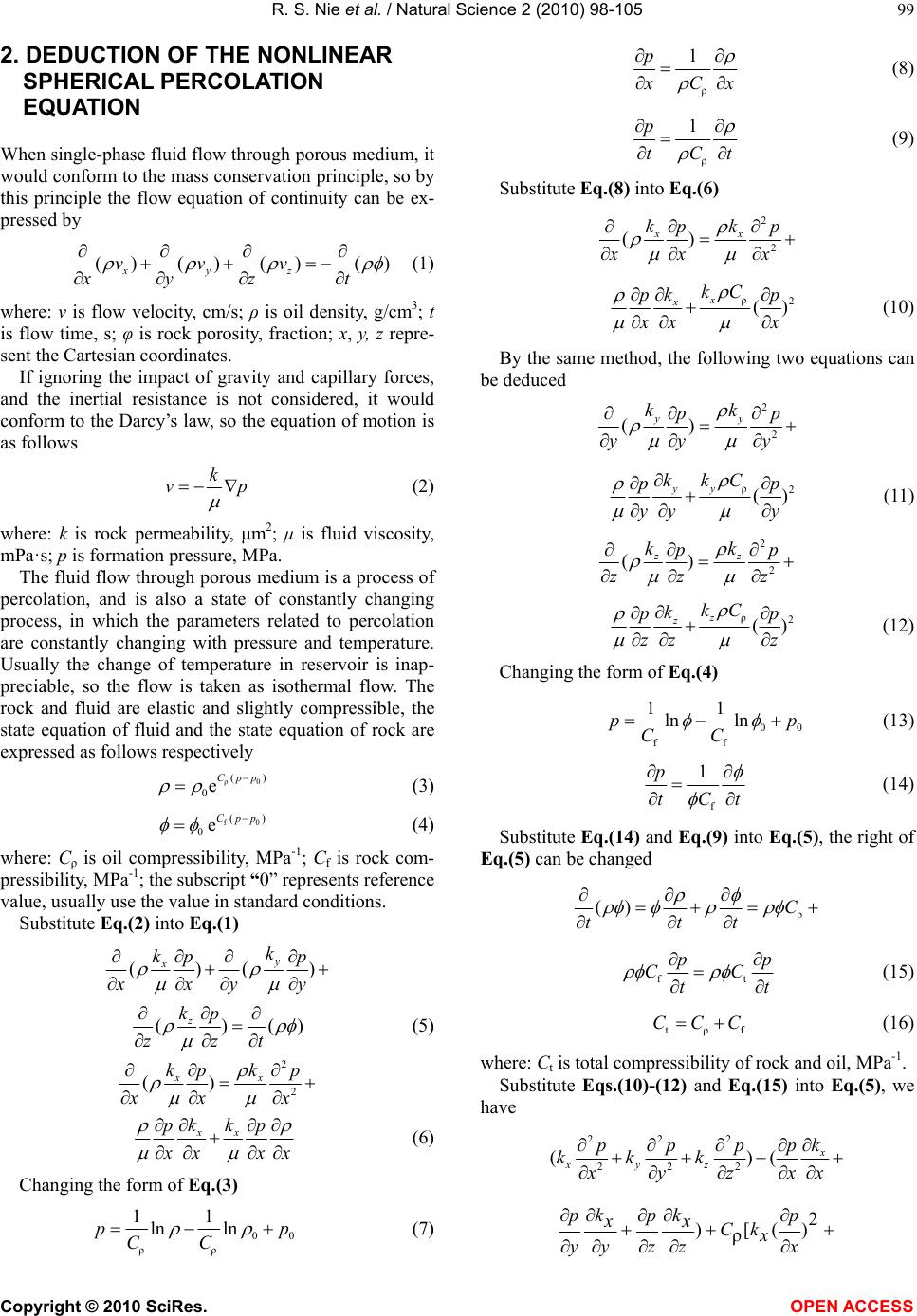 R. S. Nie et al. / Natural Science 2 (2010) 98-105 Copyright © 2010 SciRes. OPEN ACCESS 99 2. DEDUCTION OF THE NONLINEAR SPHERICAL PERCOLATION EQUATION When single-phase fluid flow through porous medium, it would conform to the mass conservation principle, so by this principle the flow equation of continuity can be ex- pressed by ()() ()() xyz vvv xyz t (1) where: v is flow velocity, cm/s; ρ is oil density, g/cm3; t is flow time, s; φ is rock porosity, fraction; x, y, z repre- sent the Cartesian coordinates. If ignoring the impact of gravity and capillary forces, and the inertial resistance is not considered, it would conform to the Darcy’s law, so the equation of motion is as follows k vp (2) where: k is rock permeability, μm2; μ is fluid viscosity, mPa· s ; p is formation pressure, MPa. The fluid flow through porous medium is a process of percolation, and is also a state of constantly changing process, in which the parameters related to percolation are constantly changing with pressure and temperature. Usually the change of temperature in reservoir is inap- preciable, so the flow is taken as isothermal flow. The rock and fluid are elastic and slightly compressible, the state equation of fluid and the state equation of rock are expressed as follows respectively ρ0 () 0eCpp (3) f0 () 0eCpp (4) where: Cρ is oil compressibility, MPa-1; Cf is rock com- pressibility, MPa-1; the subscript “0” represents reference value, usually use the value in standard conditions. Substitute Eq.(2) into Eq.(1) ()() y xk kpp x xy y ()() z kp zzt (5) 2 2 () xx kk pp xx x xx kk pp x xxx (6) Changing the form of Eq.(3 ) 00 ρρ 11 ln ln pp CC (7) ρ 1p x Cx (8) ρ 1p tCt (9) Substitute Eq.(8) into Eq.(6) 2 2 () xx kk pp xx x ρ2 () x xkC k pp x xx (10) By the same method, the following two equations can be deduced 2 2 () yy kk pp yy y ρ2 () yy kkC pp yy y (11) 2 2 () zz kk pp zz z ρ2 () z zkC k pp zz z (12) Changing the form of Eq.(4) 00 ff 11 ln ln pp CC (13) f 1p tCt (14) Substitute Eq.(1 4) and Eq.(9) in to Eq.(5), the right of Eq.(5) can be changed ρ () C ttt ft pp CC tt (15) tρf CCC (16) where: Ct is total compressibility of rock and oil, MPa-1. Substitute Eqs.(10)-(12) and Eq.(15) into Eq. (5 ), we have 222 222 ()( x xyz k pppp kkk x x xyz 2 )[() ρ kk pp p xx Ck x yy zzx  R. S. Nie et al. / Natural Science 2 (2010) 98-105 Copyright © 2010 SciRes. OPEN ACCESS 100 22 t () ()] yz pp p kk C yz t (17) If the permeability is isotropic and constant, /0,/0,/0 xyy kr kr kr, the Eq.(17) be- comes 222 2 ρ 222 ()[() ppp p Cx xyz 22 t () ()]C pp p yz kt (18) Eq.(18) is the governing differential equation in Car- tesian coordinates, the equation in radial spherical coor- dinates becomes 22 t ρ 2 1()() C pp p rC rrr ktr (19) where, r represents the radial spherical coordinates. Eq.(19) is the nonlinear flow governing partial dif- ferential equation with quadratic pressure gradient term. We call the second power of the pressure gradient as quadratic pressure gradient. The function exp(x) by use of Maclaurin series expan- sion is written by 2 exp()1/ 2/! n xxx xn (20) If we use Maclaurin series expansion for Eqs.(3) and (4) and neglect the second order and the above higher order item, the Eqs.(3) and (4) can be rewritten by Eqs. (21) and (22) respectively 0ρ0 [1 ()]Cp p (21) 0f 0 [1 ()]Cpp (22) The appearance of quadratic pressure gradient term is simply because that we didn’t make any simplification for the state Eqs. (3) and (4) in the deduction of the flow governing partial differential equation. If we use Eqs. (21) and (22), instead of Eqs.(3) and (4), in the deduc- tion of the flow governing partial differential equation, the quadratic pressure gradient term will not come up, and the deduced flow equation is the conventional linear flow equation, which is shown in almost any percolation mechanics books and papers, so the deduction of the linear flow equation is certainly omitted here. Owing to the existence of quadratic pressure gradient, the flow equation takes on nonlinear properties. Therefore it can be safely concluded that the conventional linear flow equation is the approximation and simplification of nonlinear flow equation with quadratic pressure gradient term, and that the nonlinear percolation law stands for the actual flow law of oil in reservoir. 3 .SPHERICAL PERCOLATION MODELS AND ITS SOLUTION 3.1. Physical Model For bottom water reservoir, the position of drilling and completion of oil well is usually in the top of the oil formation, the flow diagram shown in Figure 1. For some reservoirs, the oil formation is very thick, the posi- tion of drilling and completion of well is usually in the middle of the formation, the flow diagram shown in Figure 2. For the two actual situations, the oil flow in the porous media is in the form of spherical percolation. Physical model assumptions are as follows: 1) A single well with partial penetration completion in the formation like Figure 1 or Figure 2 products at con- stant rate, the external boundary may be infinite or closed or constant pressure; 2) The rock and the single-phase fluid are slightly compressible, a constant compressibility; 3) Isothermal and Darcy flow, the permeability and porosity of isotropic properties; r w r sw p e r e h b p sw Well Formation Figure 1. Spherical flow diagram for well completion posi- tion in the top of the formation. b h r sw p w Well Formation Figure 2. Spherical flow diagram for well completion posi- tion in the middle of the formation. 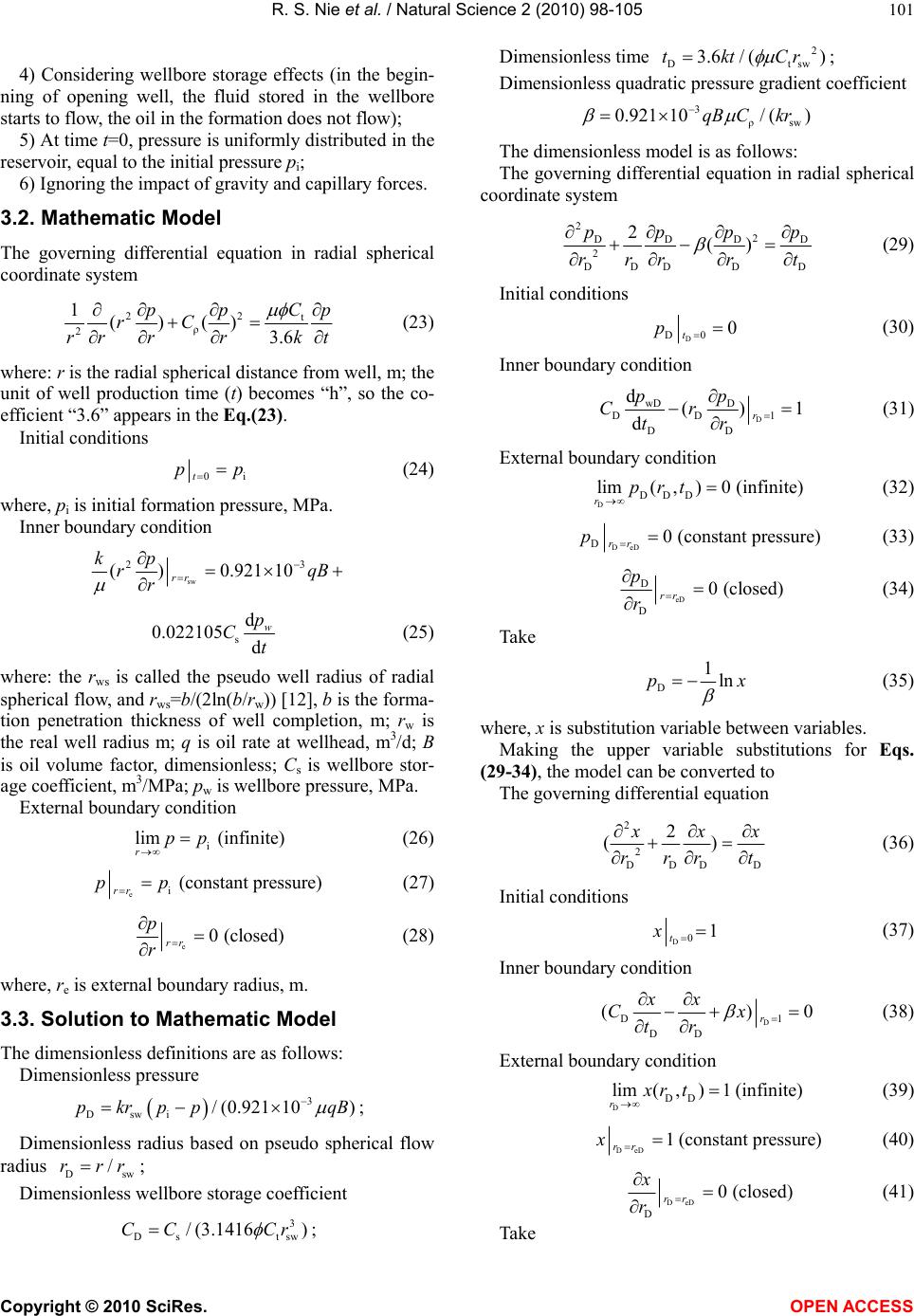 R. S. Nie et al. / Natural Science 2 (2010) 98-105 Copyright © 2010 SciRes. OPEN ACCESS 101 4) Considering wellbore storage effects (in the begin- ning of opening well, the fluid stored in the wellbore starts to flow, the oil in the formation does not flow); 5) At time t=0, pressure is uniformly distributed in the reservoir, equal to the initial pressure pi; 6) Ignoring the impact of gravity and capillary forces. 3.2. Mathematic Model The governing differential equation in radial spherical coordinate system 22 t ρ 2 1()() 3.6 C pp p rC rr rktr (23) where: r is the radial spherical distance from well, m; the unit of well production time (t) becomes “h”, so the co- efficient “3.6” appears in the Eq.(23). Initial conditions 0it pp (24) where, pi is initial formation pressure, MPa. Inner boundary condition sw 23 ()0.921 10 rr kp rqB r s d 0.022105 d w p Ct (25) where: the rws is called the pseudo well radius of radial spherical flow, and rws=b/(2ln(b/rw)) [12], b is the forma- tion penetration thickness of well completion, m; r w is the real well radius m; q is oil rate at wellhead, m3/d; B is oil volume factor, dimensionless; Cs is wellbore stor- age coefficient, m3/MPa; pw is wellbore pressure, MPa. External boundary condition i lim (infinite) rpp (26) ei (constant pressure) rr pp (27) e0 (closed) rr p r (28) where, re is external boundary radius, m. 3.3. Solution to Mathematic Model The dimensionless definitions are as follows: Dimensionless pressure 3 Dswi / (0.92110)pkrppqB ; Dimensionless radius based on pseudo spherical flow radius Dsw /rrr; Dimensionless wellbore storage coefficient 3 Ds tsw / (3.1416)CC Cr ; Dimensionless time 2 Dtsw 3.6/()tktCr ; Dimensionless quadratic pressure gradient coefficient 3 ρsw 0.92110/ ()qB Ckr The dimensionless model is as follows: The governing differential equation in radial spherical coordinate system 2 2 DDDD 2 DDD DD 2() pppp rrr tr (29) Initial conditions D D0 0 t p (30) Inner boundary condition D wD D DD1 DD d()1 dr pp Cr tr (31) External boundary condition D DDD lim(,)0 (infinite) rprt (32) DeD D0 (constant pressure) rr p (33) eD D D 0 (closed) rr p r (34) Take D 1lnpx (35) where, x is substitution variable between variables. Making the upper variable substitutions for Eqs. (29-34), the model can be converted to The governing differential equation 2 2 DD DD 2 () x xx rr tr (36) Initial conditions D01 t x (37) Inner boundary condition D D1 DD ()0 r xx Cx tr (38) External boundary condition D DD lim(,)1 (infinite) rxr t (39) DeD 1 (constant pressure) rr x (40) DeD D 0 (closed) rr x r (41) Take 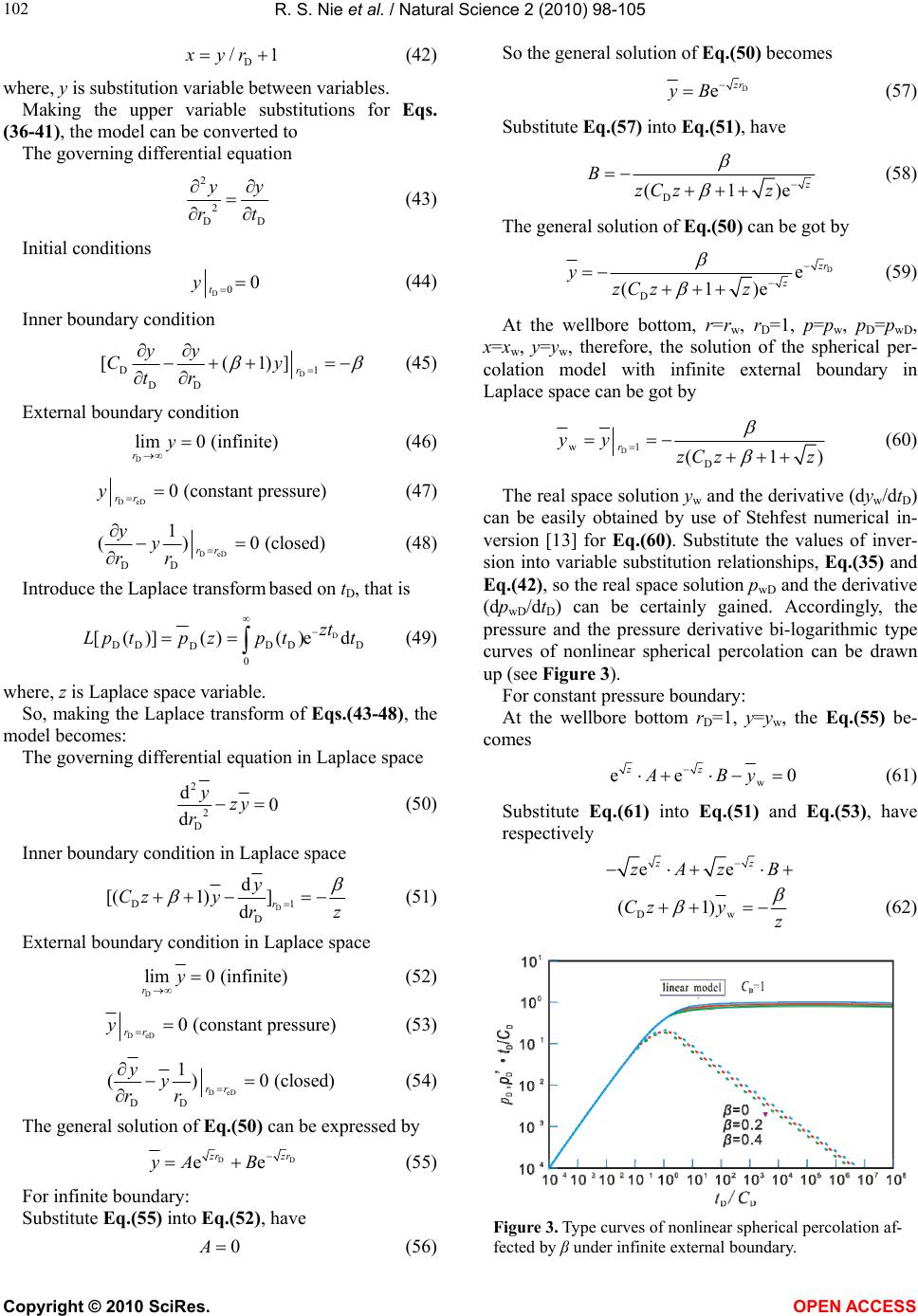 R. S. Nie et al. / Natural Science 2 (2010) 98-105 Copyright © 2010 SciRes. OPEN ACCESS 102 D /1xyr (42) where, y is substitution variable between variables. Making the upper variable substitutions for Eqs. (36-41), the model can be converted to The governing differential equation 2 2 DD yy tr (43) Initial conditions D00 t y (44) Inner boundary condition D D1 DD [(1)] r yy Cy tr (45) External boundary condition D lim0 (infinite) ry (46) DeD 0 (constant pressure) rr y (47) DeD DD 1 ()0 (closed) rr yy rr (48) Introduce the Laplace transform based on tD, that is D DDDD D D 0 [()]()()e d zt Lp tpzp tt (49) where, z is Laplace space variable. So, making the Laplace transform of Eqs.(43-48), the model becomes: The governing differential equation in Laplace space 2 2 D d0 d yzy r (50) Inner boundary condition in Laplace space D D1 D d [(1) ] dr y Czy rz (51) External boundary condition in Laplace space D lim0 (infinite) ry (52) DeD 0 (constant pressure) rr y (53) DeD DD 1 ()0 (closed) rr yy rr (54) The general solution of Eq.(50) can be expressed by DD ee z rzr yA B (55) For infinite boundary: Substitute Eq.(55) into Eq.(52), have 0A (56) So the general solution of Eq.(50) becomes D e z r yB (57) Substitute Eq.(57) into Eq.(51), have D (1)e z B zC zz (58) The general solution of Eq.(50) can be got by D D e (1)e z r z y zC zz (59) At the wellbore bottom, r=rw, rD=1, p=pw, pD=pwD, x=xw, y=yw, therefore, the solution of the spherical per- colation model with infinite external boundary in Laplace space can be got by D1 w D (1) r yy zCzz (60) The real space solution yw and the derivative (dyw/dtD) can be easily obtained by use of Stehfest numerical in- version [13] for Eq.(60). Substitute the values of inver- sion into variable substitution relationships, Eq.(35) and Eq.(42), so the real space solution pwD and the derivative (dpwD/dtD) can be certainly gained. Accordingly, the pressure and the pressure derivative bi-logarithmic type curves of nonlinear spherical percolation can be drawn up (see Figure 3). For constant pressure boundary: At the wellbore bottom rD=1, y=yw, the Eq.(55) be- comes w ee 0 zz ABy (61) Substitute Eq.(61) into Eq.(51) and Eq.(53), have respectively ee zz zAz B Dw (1)Czy z (62) Figure 3. Type curves of nonlinear spherical percolation af- fected by β under infinite external boundary.  R. S. Nie et al. / Natural Science 2 (2010) 98-105 Copyright © 2010 SciRes. OPEN ACCESS 103 eD eD ee 0 zr zr AB (63) For closed boundary: Substitute Eq.(61) into Eq.(54), have eD eD eD eD (1)e(1)e 0 zr zr zrA zrB (64) Combining Eqs.(61-64) , the coefficients A and B and the function at wellbore w y in Laplace space can be easily obtained by use of some linear algebra method (such as Gauss-Jordan reduction, etc), then nonlinear spherical percolation type curves can also be drawn up (see Figure 4 and Figure 5) by use of the same method. 4. CHARACTERISTICS OF THE NONLINEAR PERCOLATION 4.1. Parameter Sensitivity Analysis to Type Curves Figure 3 shows the type curves of nonlinear spherical percolation affected by β under infinite external bound- ary. Can be seen from the figure, the curves vary with the value of the dimensionless quadratic pressure gradi- ent coefficient β (from up to down, β=0, 0.2, 0.4), when β=0 it is just the curve of linear percolation model. It can be easily seen that the curves have the trait of unit slope in the wellbore storage stage, which shows that there is no influence of quadratic pressure gradient in this flow stage, and that the location of the pressure and the pres- sure derivative curves is lower than that of the conven- tional linear model curve in the stage of infinite-acting radial spherical flow. The bigger the β is, the greater the offset is. Figure 4 and Figure 5 show the type curves of nonlinear spherical percolation affected by β under con- stant pressure external boundary and closed external boundary respectively. Can be seen from the figures, the trait of unit slope in the wellbore storage stage still exist and there still exists a offset due to the effect of β, but in the late flow stage of boundary response the pressure derivative curves is going down until focusing on a point for constant pressure boundary and the pressure deriva- tive curves is going up until focusing on a line together with the pressure curves for closed boundary, which is completely different from Figure 1. Figure 6 shows the type curves of nonlinear spherical percolation affected by CD under infinite external boundary. Can be seen from the figure, the curves vary with the value of the dimensionless wellbore storage coefficient CD, and the bigger the CD is, the lower thepressure derivative curve is. Figure 7 shows the type curves of nonlinear spherical percolation affected by reD under different external boundaries. Can be seen from the figure, the curves vary with the value of the dimen- Figure 4. Type curves of nonlinear spherical percolation af- fected by β under constant pressure external boundary. Figure 5. Type curves of nonlinear spherical percolation af- fected by β under closed external boundary. Figure 6. Type curves of nonlinear spherical percolation af- fected by CD. sionless radial spherical radius reD, and the bigger the reD is, the later the time of going up or going down is. According to the definition of β and the probable val- ues of β (Table 1), it is clearly demonstrated that β is proportional to oil viscosity μ, and inversely proportional to formation permeability k. So there is usually a bigger β for the low permeability, heavy oil reservoirs, and the influence of the quadratic pressure gradient nonlinear term is very distinct, the quadratic pressure gradient should not be neglected. For the fixed group of parame- ters (q, B, Cρ), the speed of pressure wave propagation 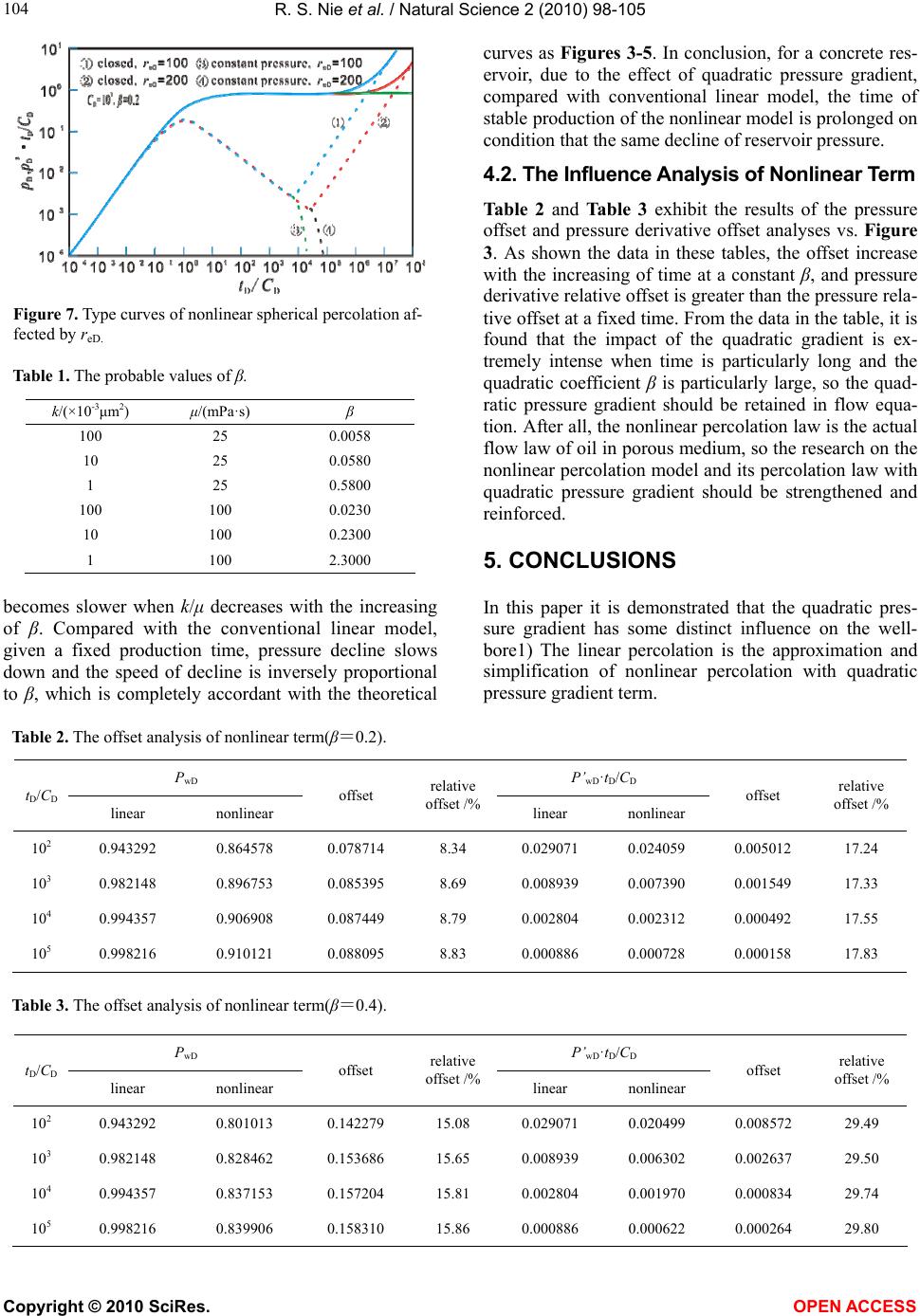 R. S. Nie et al. / Natural Science 2 (2010) 98-105 Copyright © 2010 SciRes. OPEN ACCESS 104 Figure 7. Type curves of nonlinear spherical percolation af- fected by reD. Table 1. The probable values of β. k/(×10-3μm2) μ/(mPa·s) β 100 25 0.0058 10 25 0.0580 1 25 0.5800 100 100 0.0230 10 100 0.2300 1 100 2.3000 becomes slower when k/μ decreases with the increasing of β. Compared with the conventional linear model, given a fixed production time, pressure decline slows down and the speed of decline is inversely proportional to β, which is completely accordant with the theoretical curves as Figures 3-5. In conclusion, for a concrete res- ervoir, due to the effect of quadratic pressure gradient, compared with conventional linear model, the time of stable production of the nonlinear model is prolonged on condition that the same decline of reservoir pressure. 4.2. The Influence Analysis of Nonlinear Term Table 2 and Table 3 exhibit the results of the pressure offset and pressure derivative offset analyses vs. Figure 3. As shown the data in these tables, the offset increase with the increasing of time at a constant β, and pressure derivative relative offset is greater than the pressure rela- tive offset at a fixed time. From the data in the table, it is found that the impact of the quadratic gradient is ex- tremely intense when time is particularly long and the quadratic coefficient β is particularly large, so the quad- ratic pressure gradient should be retained in flow equa- tion. After all, the nonlinear percolation law is the actual flow law of oil in porous medium, so the research on the nonlinear percolation model and its percolation law with quadratic pressure gradient should be strengthened and reinforced. 5. CONCLUSIONS In this paper it is demonstrated that the quadratic pres- sure gradient has some distinct influence on the well- bore1) The linear percolation is the approximation and simplification of nonlinear percolation with quadratic pressure gradient term. Table 2. The offset analysis of nonlinear term(β=0.2). PwD P’wD·tD/CD tD/CD linear nonlinear offset relative offset /% linear nonlinear offset relative offset /% 102 0.943292 0.864578 0.078714 8.34 0.029071 0.024059 0.005012 17.24 103 0.982148 0.896753 0.085395 8.69 0.008939 0.007390 0.001549 17.33 104 0.994357 0.906908 0.087449 8.79 0.002804 0.002312 0.000492 17.55 105 0.998216 0.910121 0.088095 8.83 0.000886 0.000728 0.000158 17.83 Table 3. The offset analysis of nonlinear term(β=0.4). PwD P’wD·tD/CD tD/CD linear nonlinear offset relative offset /% linear nonlinear offset relative offset /% 102 0.943292 0.801013 0.142279 15.08 0.029071 0.020499 0.008572 29.49 103 0.982148 0.828462 0.153686 15.65 0.008939 0.006302 0.002637 29.50 104 0.994357 0.837153 0.157204 15.81 0.002804 0.001970 0.000834 29.74 105 0.998216 0.839906 0.158310 15.86 0.000886 0.000622 0.000264 29.80  R. S. Nie et al. / Natural Science 2 (2010) 98-105 Copyright © 2010 SciRes. OPEN ACCESS 105 2) The new-style type curves of nonlinear spherical percolation with quadratic pressure gradient effect in shape and characteristics are obviously different from the type curves of linear model, the location of the pres- sure and the pressure derivative curves is lower than that of the conventional linear model curve. 3) The type curves are affected by the quadratic gra- dient coefficient β, the offset of pressure and pressure derivative is directly proportional to β and time. 4) For a concrete reservoir, due to the effect of quad- ratic pressure gradient, compared with conventional lin- ear model, the time of stable production of the nonlinear model is prolonged on condition that the same decline of reservoir pressure. 5) The impact of the quadratic pressure gradient under certain conditions is extremely intense, especially for the low permeability and heavy oil reservoirs, and the quad- ratic pressure gradient term should not be neglected and should be retained in flow equation. 6) The nonlinear percolation law is the actual flow law of oil in porous medium, so the research on the nonlinear flow model and its application with quadratic pressure gradient should be strengthened and reinforced. REFERENCES [1] Yan, B.S. and Ge, J.L. (2003) New advances of modern reservoir and fluid flow in porous media. Journal of Southwest Petroleum Institute, 25(1), 29-32, (in Chi- nese). [2] Odeh, A.S and Babu, D.K. (1998) Comprising of solu- tions for the nonlinear and linearized diffusion equations. SPE Reservoir Engineering, 3(4), 1202-1206. [3] Bai, M.Q. and Roegiers, J.C. (1994) A nonlinear dual porosity model. Appl Math Moclellin, 18(9), 602-610. [4] Wang, Y. and Dusseault, M.B. (1991) The effect of quad- ratic gradient terms on the borehole solution in poroelas- tic media. Water Resource Research, 27(12), 3215-3223. [5] Chakrabarty, C., Farouq, A.S.M. and Tortike, W.S. (1993) Analytical solutions for radial pressure distribution in- cluding the effects of the quadratic gradient term. Water Resource Research, 29(4), 1171-1177. [6] Braeuning, S., Jelmert, T.A. and Sven, A.V. (1998) The effect of the quadratic gradient term on variable-rate well-tests, Journal of Petroleum Science and Engineering, 21(2), 203-222. [7] Tong, D.K. (2003) The fluid mechanics of nonlinear flow in porous media. Beijing: Petroleum Industry Press in Chinese, (in Chinese). [8] Tong, D.K., Zhang, Q.H. and Wang, R.H. (2005) Exact solution and its behavior characteristic of the nonlinear dual-porosity model. Applied Mathematic and Mechanics, 26(10), 1161-1167, (in Chinese). [9] William, E.B., James, M. and Peden, K.F.N. (1980) The analysis of spherical flow with wellbore storage. SPE 9294. [10] Charles, A.K. and William, A.A. (1982) Application of linear spherical flow analysis techniques to field prob- lems-case studies. SPE 11088. [11] Mark, A. and Proett, W.C.C. (1998) New exact spherical flow solution with storage and skin for early-time inter- pretation with applications to wireline formation and early-evaluation drillstem testing. SPE 49140. [12] Joseph, J.A. and Koederitz, L.F. (1985) Unsready-state spherical flow with storage and skin. SPEJ, 25(6), 804-822. [13] Stehfest H. (1970) Numerical inversion of Laplace transform algorithm 368, Communication of the ACM, 13(1), 47-49. |

